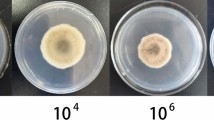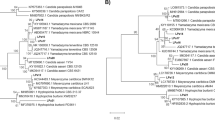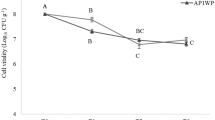Abstract
Postharvest loss is a major constraint in the production of grapes, both in terms of quality and quantity. In this study, 33 yeasts were isolated from the fructosphere of grapes and tested for their antifungal activity against Aspergillus spp., which infects grapes during the postharvest stage. The results revealed that the yeast isolate YBB3 exhibited maximum inhibitory effect against Aspergillus spp. in dual plate assay (57% over control). Molecular characterization of YBB3 showed 99.31% identity with Hanseniaspora guilliermondii. Wound site colonization of H. guilliermondii in grape cv. Thompson Seedless showed 80% inhibition of Aspergillus spp. over the control in vitro. YBB3 produced volatile, non-volatile and thermostable compounds, which inhibited the mycelial growth of Aspergillus spp. In addition, YBB3 produced killer toxins, which were identified by the presence of blue colour-stained cells. Moreover, glycerol-based liquid bioformulations of H. guilliermondii (YBB3) showed maximum inhibitory effect against Aspergillus spp. (96%) over the control on inoculated wounded grapes berries. Thus, the yeast isolate H. guilliermondii identified and characterized in this study is worthy of further studies for the sustainable management of Aspergillus rot in grapes.






Similar content being viewed by others
References
Abadias M, Teixidó N, Usall J, Viñas I (2003) Optimization of growth conditions of the postharvest biocontrol agent Candida sake CPA-1 in a lab-scale fermenter. J Appl Microbiol 95(2):301–309
Abdelhai MH, Awad FN, Yang Q, Mahunu GK, Godana EA, Zhang H (2019) Enhancement the biocontrol efficacy of Sporidiobolus pararoseus Y16 against apple blue mold decay by glycine betaine and its mechanism. Biol Control 139:104079
Abeer H, Abd-Allah EF, Al-Obeed RS, Mridha MAU, Al-Huqail AA (2013) Non-chemical strategies to control postharvest losses and extend the shelf life of table grape fruits. Biol Agri Horti 29(2):82–90
Apaliya MT, Zhang H, Zheng X, Yang Q, Mahunu GK, Kwaw E (2018) Exogenous trehalose enhanced the biocontrol efficacy of Hanseniaspora uvarum against grape berry rots caused by Aspergillus tubingensis and Penicillium commune. J Sci Food Agric 98:4665–4672
Arfaoui M, Vallance J, Bruez E, Rezgui A, Melki I, Chebil S, Sadfi-Zouaoui N, Rey P (2019) Isolation, identification and in vitro characterization of grapevine rhizobacteria to control ochratoxigenic Aspergillus spp. on grapes. Biol Control 129:201–211
Brent KJ, Hollomon DW (2007) Fungicide resistance in crop pathogens: How can it be managed? FRAC Monograph No. 1 (Second, revised edition) ed: Croplife International, Brussels, Belgium
Cai Z, Yang R, Xiao H, Qin X, Si L (2015) Effect of preharvest application of Hanseniaspora uvarum on postharvest diseases in strawberries. Postharvest Biol Technol 100:52–58
Chan Z, Tian S (2006) Induction of H2O2-metabolizing enzymes and total protein synthesis by antagonistic yeast and salicylic acid in harvested sweet cherry fruit. Postharvest Biol Technol 39(3):314–320
Chanchaichaovivat A, Ruenwongsa P, Panijpan B (2007) Screening and identification of yeast strains from fruits and vegetables: Potential for biological control of postharvest chilli anthracnose (Colletotrichum capsici). Biol Control 42(3):326–335
Cordero-Bueso G, Mangieri N, Maghradze D, Foschino R, Valdetara F, Cantoral JM, Vigentini I (2017) Wild grape-associated yeasts as promising biocontrol agents against Vitis vinifera fungal pathogens. Front Microbiol 8:2025
da Cunha T, Ferraz LP, Wehr PP, Kupper KC (2018) Antifungal activity and action mechanisms of yeasts isolates from citrus against Penicillium italicum. Int J Food Microbiol 276:20–27
Droby S, Wisniewski M, Teixidó N, Spadaro D, Jijakli M (2016) The science, development, and commercialization of postharvest biocontrol products. Postharvest Biol Technol 122:22–29
Eckert JW, Ogawa JM (1985) The chemical control of postharvest diseases: subtropical and tropical fruits. Annu Rev Phytopathol 23(1):421–454
Fredlund E, Druvefors UÄ, Olstorpe MN, Passoth V, Schnürer J (2004) Influence of ethyl acetate production and ploidy on the anti-mould activity of Pichia anomala. FEMS Microbiol Lett 238(1):133–137
Giobbe S, Marceddu S, Scherm B, Zara G, Mazzarello VL, Budroni M, Migheli Q (2007) The strange case of a biofilm-forming strain of Pichia fermentans, which control Monilinia brown rot on apple but is pathogenic on peach fruit. FEMS Yeast Res 7(8):1389–1398
Hua SST, Beck JJ, Sarreal SBL, Gee W (2014) The major volatile compound 2-phenylethanol from the biocontrol yeast, Pichia anomala, inhibits growth and expression of aflatoxin biosynthetic genes of Aspergillus flavus. Mycotoxin Res 30 (2):L 71–78
Jamalizadeh M, Etebarian HR, Aminian H, Alizadeh A (2011) A review of mechanisms of action of biological control organisms against post-harvest fruit spoilage. EPPO Bulletin 41(1):65–71
Jeandet P, Douillet-Breuil AC, Bessis R, Debord S, Sbaghi M, Adrian M (2002) Phytoalexins from the Vitaceae: biosynthesis, phytoalexin gene expression in transgenic plants, antifungal activity, and metabolism. J Agri Food Chem 50(10):2731–2741
Kasfi K, Taheri P, Jafarpour B, Tarighi S (2018) Identification of epiphytic yeasts and bacteria with potential for biocontrol of grey mold disease on table grapes caused by Botrytis cinerea. Spanish J Agri Res 16(1):e1002
Kinay P, Yildiz M (2008) The shelf life and effectiveness of granular formulations of Metschnikowia pulcherrima and Pichia guilliermondii yeast isolates that control post-harvest decay of citrus fruit. Biol Control 45(3):433–440
Kumar S, Stecher G, Tamura K (2016) MEGA7: Molecular Evolutionary Genetics Analysis version 7.0. for bigger datasets. Mol Biol Evol 33:1870–1874
Li W, Zhang H, Li P, Apaliya MT, Yang Q, Peng Y, Zhang X (2016) Biocontrol of postharvest green mold of oranges by Hanseniaspora uvarum Y3 in combination with phosphatidylcholine. Biol Control 103:30–38
Lima JRD, Viana FMP, Lima FA, Pieniz V, Gonçalves LRB (2014) Efficiency of a yeast-based formulation for the biocontrol of postharvest anthracnose of papayas. Summa Phytopathol 40(3):203–211
Liu J, Sui Y, Wisniewski M, Droby S, Liu Y (2013) Review: Utilization of antagonistic yeasts to manage postharvest fungal diseases of fruit. Int J Food Microbiol 167(2):153–160
Melin P, Hakansson S, Eberhard TH, Schnurer J (2006) Survival of the biocontrol yeast Pichia anomala after long-term storage in liquid formulations at different temperatures, assessed by flow cytometry. J Appl Microbiol 100(2):264–271
Melin P, Hakansson S, Schnurer J (2007) Optimisation and comparison of liquid and dry formulations of the biocontrol yeast Pichia anomala J121. Appl Microbiol Biotechnol 73(5):1008–1016
Mokhtarnejad L, Etebarian HR, Fazeli MR, Jamalifar H (2011) Evaluation of different formulations of potential biocontrol yeast isolates efficacy on apple blue mold at storage condition. Arch Phytopathol Pl Protec 44(10):970–980
Nadai C, Fernandes Lemos WJJ, Favaron F, Giacomini A, Corich V (2018) Biocontrol activity of Starmerella bacillaris yeast against blue mold disease on apple fruit and its effect on cider fermentation. PLoS ONE 13(9):e0204350
Pantelides IS, Christou O, Tsolakidou MD, Tsaltas D, Ioannou N (2015) Isolation, identification and in vitro screening of grapevine yeasts for the control of black aspergilli on grapes. Biol Control 88:46–53
Parafati L, Vitale A, Restuccia C, Cirvilleri G (2015) Biocontrol ability and action mechanism of food-isolated yeast strains against Botrytis cinerea causing post-harvest bunch rot of table grape. Food Microbiol 47:85–92
Patino-Vera M, Jimenez B, Balderas K, Ortiz M, Allende R, Carrillo A, Galindo E (2005) Pilot-scale production and liquid formulation of Rhodotorula minuta, a potential biocontrol agent of mango anthracnose. J Appl Microbiol 99(3):540–550
Ponsone ML, Chiotta ML, Combina M, Dalcero A, Chulze S (2011) Biocontrol as a strategy to reduce the impact of ochratoxin A and Aspergillus section Nigri in grapes. Int J Food Microbiol 151(1):70–77
Pretscher J, Fischkal T, Branscheidt S, Jäger L, Kahl S, Schlander M, Thines E, Claus H (2018) Yeasts from different habitats and their potential as biocontrol agents. Fermentation 4(2):31
Saravanakumar D, Ciavorella A, Spadaro D, Garibaldi A, Gullino ML (2008) Metschnikowia pulcherrima strain MACH1 outcompetes Botrytis cinerea, Alternaria alternata and Penicillium expansum in apples through iron depletion. Postharvest Biol Technol 49(1):121–128
Senthil R, Prabakar K, Rajendran L, Karthikeyan G (2011) Efficacy of different biological control agents against major postharvest pathogens of grapes under room temperature storage conditions. Phytopathol Mediterr 50(1):55–65
Sharma RR, Singh D, Singh R (2009) Biological control of postharvest diseases of fruits and vegetables by microbial antagonists: a review. Biol Control 50(3):205–221
Sipiczki M (2006) Metschnikowia strains isolated from botrytized grapes antagonize fungal and bacterial growth by iron depletion. Appl Environ Microbiol 72(10):6716–6724
Spadaro D, Droby S (2016) Development of biocontrol products for postharvest diseases of fruit: The importance of elucidating the mechanisms of action of yeast antagonists. Trends Food Sci Technol 47:39–49
Suzzi G, Romano P, Ponti I, Montuschi C (1995) Natural wine yeasts as biocontrol agents. J Appl Bacteriol 78(3):304–308
Taqarort N, Echairi A, Chaussod R, Nouaim R, Boubaker H, Benaoumar AA, Boudyach E (2008) Screening and identification of epiphytic yeasts with potential for biological control of green mold of citrus fruits. World J Microbiol Biotechnol 24(12):3031–3038
Wang M, Zhao L, Zhang X, Dhanasekaran S, Abdelhai MH, Yang Q, Jiang Z, Zhang H (2019) Study on biocontrol of postharvest decay of table grapes caused by Penicillium rubens and the possible resistance mechanisms by Yarrowia lipolytica. Biol Control 130:110–117
Wilson CL, Wisniewski ME (1989) Biological control of postharvest diseases of fruits and vegetables: an emerging technology. Annu Rev Phytopathol 27(1):425–441
Wisniewski M, Wilson C, Droby S, Chalutz E, El Ghaouth A, Stevens C (2007) Postharvest biocontrol: new concepts and applications. Biological control: A global perspective. United Kingdom, CABI International, 262–273
Yang Q, Wang H, Zhang H, Zhang X, Apaliya MT, Zheng X, Mahunu G (2017) Effect of Yarrowia lipolytica on postharvest decay of grapes caused by Talaromyces rugulosus and the protein expression profile of T. rugulosus. Postharvest Biol Technol 126:15–22
Zahavi T, Cohen L, Weiss B, Schena L, Daus A, Kaplunov T, Zutkhi J, Ben-Arie R, Droby S (2000) Biological control of Botrytis, Aspergillus and Rhizopus rots on table and wine grapes in Israel. Postharvest Biol Technol 20:115–124
Zhang H, Mahunu GK, Castoria R, Yang Q, Apaliya M (2018) Recent developments in the enhancement of some postharvest biocontrol agents with unconventional chemicals compounds. Trends Food Sci Technol 78:180–187
Zhang Q, Zhao L, Li Z, Li C, Li B, Gu X, Zhang X, Zhang H (2019) Screening and identification of antagonistic yeast controlling postharvest blue mold decay of pears and the possible mechanisms involved. Biol Control 133:26–33
Zhimo V, Bhutia D, Saha J (2016) Biological control of post harvest fruit diseases using antagonistic yeasts in India. J Plant Pathol 98:275–283
Acknowledgements
The authors acknowledge the Department of Plant Pathology, Agricultural College and Research Institute, Madurai, Tamil Nadu, India for providing necessary facilities to carry out the research work.
Author information
Authors and Affiliations
Corresponding author
Ethics declarations
Conflict of interest
No funding was obtained for this study. All authors have no conflict of interest to declare.
Additional information
Publisher's Note
Springer Nature remains neutral with regard to jurisdictional claims in published maps and institutional affiliations.
Rights and permissions
About this article
Cite this article
Nandhini, M., Harish, S., Aiyanathan, K.E.A. et al. Glycerol-based liquid formulation of the epiphytic yeast Hanseniaspora guilliermondii isolate YBB3 with multiple modes of action controls postharvest Aspergillus rot in grapes. J Plant Pathol 103, 1253–1264 (2021). https://doi.org/10.1007/s42161-021-00909-y
Received:
Accepted:
Published:
Issue Date:
DOI: https://doi.org/10.1007/s42161-021-00909-y




